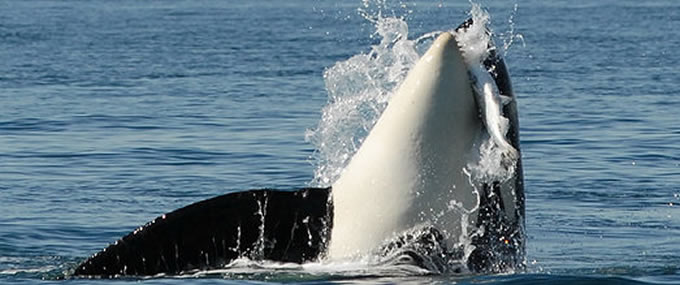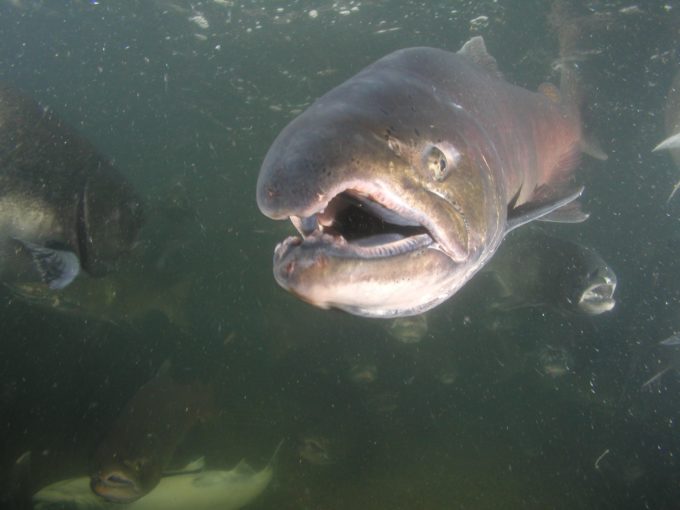Rivers Connect Us, and Salmon, and Orcas
This Orca Whale Awareness month, did you know Orca recovery is dependent on salmon recovery?

Every spring, a distinct population of orca whales known as the Southern Resident Killer Whales (SRKW) waits at the mouth of the Columbia River like students in a cafeteria line. On the menu: 30+lb spring chinook salmon, the largest and fattiest of the six salmon species found off the Puget Sound.
The Center for Whale Research estimates that the average SRKW consumes between 18-25 salmon per day. With only about 80 members of this population left, that’s 1,500-2,000 salmon every day! Chinook are their favorite by far, making up as much as 80% of these whales’ diets, though they also enjoy a sampling of coho, chum, and steelhead.
Anadromous fish have a complex lifecycle, one that begins in freshwater streams, segues into the ocean, and ends in the same stream of the salmon’s birth, where the ones who don’t end up an orca’s lunch return to spawn and die. They are a remarkable, resilient keystone species but they are vulnerable at every stage of that life cycle.
Rivers that historically produced millions of salmon now suffer from dams, lack of fish passage, overfishing, algal blooms, non-point source pollution, and the disconnection and development of floodplains. The oceans themselves are growing more acidic, impeding salmons’ ability to detect predators and survive to spawn the next generation. As salmonid populations dwindle, meals for the SRKW grow fewer and farther between. Luckily, efforts are underway to restore salmon populations and habitats, and to help them face the challenges of a changing climate. American Rivers is deeply involved in such work in the Pacific Northwest.
The Yakima Basin:
Washington’s Yakima River once boasted the second-largest salmon run in the Columbia system. More than 800,000 chinook, coho, sockeye, steelhead, and cutthroat returned to spawn in its tributaries every year. Their presence supported the Yakama Nation and other Columbia Basin tribes, as well as complex headwater ecosystems throughout the Central Cascades.
Competing demands on the Yakima River’s waters did not turn out in favor of the fish. As agriculture grew, large irrigation reservoirs were constructed without fish passage facilities. In just a few decades summer chinook, coho, and sockeye went locally extinct, while spring and fall chinook barely hung on alongside steelhead. Thanks to lack of passage, low and altered flows, increasing temperatures, overfishing, and past land mismanagement, only 3,000-4,000 salmon remained in the Yakima system by 1990.
After a devastating series of droughts in the 90s and 00s, an unprecedented group of stakeholders came together to discuss the Yakima Basin’s water supply woes in 2009. Realizing that suing one another wasn’t providing anyone with the water they wanted, government agencies, tribal entities, irrigators, county commissioners, recreation groups, and environmental nonprofits convened a Workgroup to sort out what each group needed. The result was the Yakima Basin Integrated Plan, a laundry list of fish passage, water conservation, habitat restoration, surface and groundwater storage, water marketing, and irrigation efficiency projects that will provide reliable water for all parties within the basin. Fish passage projects are among the Integrated Plan’s first major construction efforts. Crews have already broken ground on a one-of-a-kind downstream helix passage system at Cle Elum reservoir. The other four Yakima Basin dams are undergoing studies to determine the best approach to provide fish with passage to spawning and rearing habitat blocked off for a century or more.
Before the Integrated Plan came together, the Yakama Nation Fisheries were hard at work returning chinook, coho, and sockeye to the basin. They drafted inter-tribal agreements to transplant salmon from other basins and established local hatcheries where they rear supplemental stock. Yakama Nation biologists join forces alongside partners like American Rivers, Trout Unlimited, and The Wilderness Society to restore instream habitat and reconnect rivers to their surrounding floodplains, giving salmon and steelhead a fighting chance against habitat degradation, development, and climate change.
Orca Awareness Month:
Killer whales, orca whales, SRKWs, and blackfish are iconic by any name. So how can you help support their recovery?
- Learn about salmon habitat restoration efforts in your area
In Washington, the Recreation and Conservation office created a Salmon Recovery Funding Board to provide grants for salmon restoration, protection, and assistance programs. In Oregon, the Water Resources Department created a Plan for Salmon and Watersheds which combines voluntary restoration actions with state, federal, and tribal projects, monitoring and scientific oversight. NOAA has also developed comprehensive recovery plans by region and species. And, of course, your local river or coastal groups are sure to have information available.
- Learn about local fish passage efforts
Dam removals, culvert replacements, and fish passage installation are all important tools in the work to boost salmon populations. The wildly successful Elwha Dam removal resulted in a local chinook boom. Chinook, coho, and sockeye have returned to the Yakima for the first time in a century thanks to the construction of new fish passage systems. Find out what’s going on near you, and get involved! Lend your voice in support, attend public meetings, or help boost their activities through social media.
- Support organizations that restore salmon-bearing streams
American Rivers is one of many Pacific Northwest nonprofits that work in local communities to organize, restore, fundraise, and lobby for the health of our rivers and the wildlife who depend on them. Learn more about our work and help us stretch it further in the future.





4 responses to “Rivers Connect Us, and Salmon, and Orcas”
Good information. Lucky me I ran across your blog by chance (stumbleupon).
I’ve book-marked it for later!
Not sure how hunting an upland game bird in eastern Washington ties in to salmon or orcas- or that yhe banning of that hunting will benefit salmon and orcas. Hunters might be the Orcas best allies.
I do think hydro and irrigation should take a back seat to salmon, or salmon should get an equal seat, at the table.
Can’t we have our cake and eat it too? Remove dams, re-work how irrigation pulls water, pay for wind/ solar that replaces every lost KWH of hydro.
Is there a way to generate hydro in–stream without dams? I think there could be lots of jobs in there…
Hey-ho, Lets Go!!
nice information.
All game and fish should be protected for at least the next 20 years. No fishing, no hunting. That will help restore the runs and the Orcas will be happy.